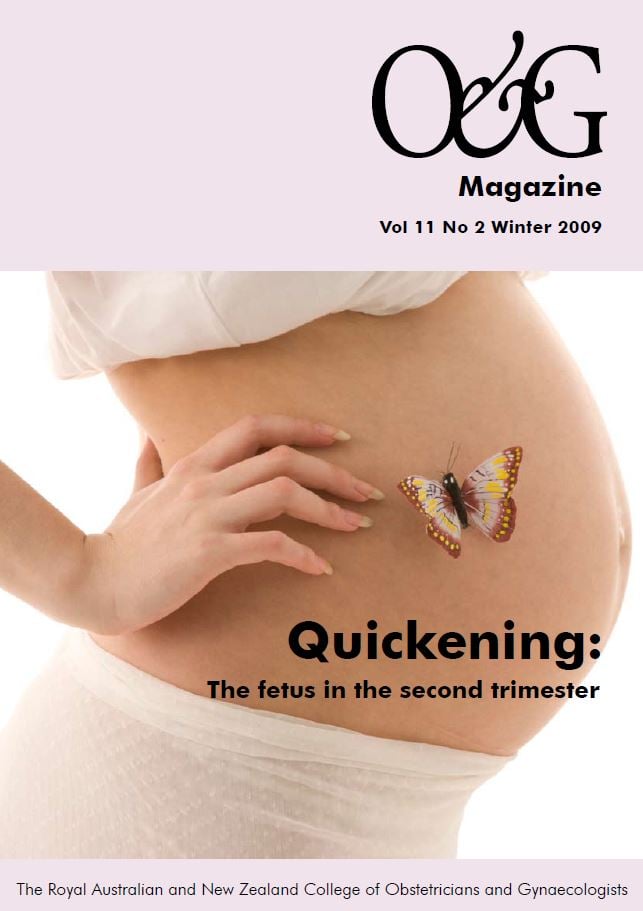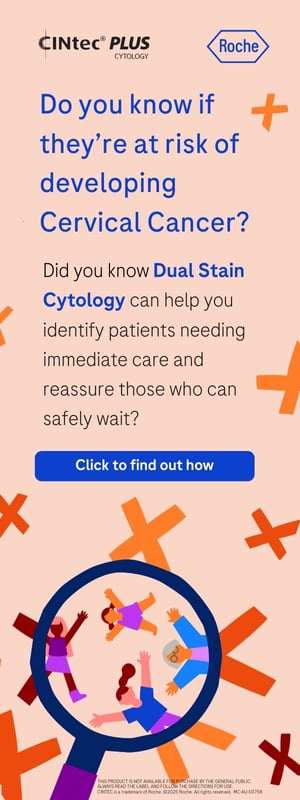Ultrasound soft markers are not in themselves abnormalities, but rather ultrasound findings which may indicate an increased risk of underlying abnormalities. Many of these markers regress as the pregnancy progresses. Although some of these markers may have value, most have not stood the test of time well.
Most of the early studies on soft markers were performed in high-risk individuals (women over 35 to 37 years of age).1 These studies were also performed in patients who had not had any other type of screening. Down syndrome screening programs are now available to many women in the form of second trimester maternal serum screening, or the more accurate first trimester serum screen combined with nuchal translucency. The high-risk patient is now well served by these screening tests and also by diagnostic tests such as amniocentesis and chorionic villous sampling.
It may be that over the next few years all of the soft markers go out of favour except nuchal fold (and possibly nasal bone). A recent prospective cohort study found isolated soft markers in ten per cent of normal fetuses and only 14 per cent of Down syndrome fetuses; nuchal fold was the only marker in this study to increase the risk of Down syndrome.2
Individual markers
1. Second trimester nasal bone
This is the newest described soft marker. There are as yet only a few large scale studies from a small group of authors. Despite this, the interim information is very encouraging. The nasal bone can be described as absent or hypoplastic. One study demonstrated that 0.5 per cent of normal fetuses and 43 per cent of trisomy 21 fetuses have an absent nasal bone at the 15 to 20 week ultrasound.3 The Fetal Medicine Foundation Group found similar figures with 1.2 per cent of normal fetuses and 62 per cent of trisomy 21 fetuses having absent or hypoplastic nasal bone between 15 and 22 weeks.3 If these figures are borne out by larger studies, then this could become the most sensitive soft marker.
2. Nuchal fold (NF)
Although a thickened NF has been associated with an increased risk of trisomy 21, it is an uncommon finding in both Down syndrome and normal fetuses.4 The NF corresponds to very similar tissue at the back of the neck as the first trimester nuchal translucency, but is measured in a different manner. This finding should be rare in fetuses that have had a prior thin nuchal translucency. If the NF is found to be thickened after a thin nuchal translucency, then other possible causes should be considered. Thickened NF may be an early feature of fetal hydrops or cystic hygroma.
3. Echogenic bowel (EB)
This is a rare finding in normal fetuses. In one study, only 0.6 per cent of mid trimester fetuses had EB but approximately 15 per cent of trisomy 21 fetuses had EB.5
Approximately 35 per cent of fetuses with true EB will have some underlying pathology.6 First trimester bleeding appears to be a common cause of EB (presumably due to swallowed blood).7 A history of first trimester bleeding does not exclude the possibility of other causes. There is an association with fetal infections. Serology for these infections should be performed. There is also an association with cystic fibrosis (due to meconium ileus). The parents should be counselled and parental testing for cystic fibrosis carrier status offered. If both partners are demonstrated to be carriers, then it is possible to perform amniocentesis for DNA analysis of the fetus.
4. Shortened long bones
Shortened humerus and femur have both been associated with an increased risk of chromosomal abnormalities.8 There are many reasons why the long bones may be shortened. If they are severely shortened or abnormal in appearance (for example, with bowing, fractures or reduced mineralisation), then this may be an indication of skeletal dysplasia. Occasionally, shortening of the long bones is a warning sign of early onset intrauterine growth restriction. It would be prudent to review the growth of the long bones in two weeks time.
Almost all studies to date have demonstrated that the humerus is a more reliable discriminator for Down syndrome than the femur.4 Measurement of humerus length should become part of the routine mid-trimester ultrasound assessment.
5. Pyelectasis
Pyelectasis or borderline renal pelvis dilatation is most commonly described as an anteroposterior diameter of the renal pelvis greater than or equal to 4mm. Approximately 17 per cent of fetuses with trisomy 21 will have pyelectasis. Isolated pyelectasis appears to be a very uncommon finding in aneuploidy. Only approximately one in every 300 fetuses with isolated pyelectasis actually have aneuploidy in three separate studies reported over more than a decade.9,10,11
A meta-analysis of soft markers confirmed the lack of significance of this finding.4 Although the likelihood ratio for this marker was 1.9 (1.9 x prior risk), the confidence interval varied between 0.7 and five. As the 95 per cent confidence interval for pyelectasis crosses one, there is a chance that, on the basis of the studies analysed, the presence of pyelectasis may actually reduce rather than increase the risk of Down syndrome.
Pyelectasis has been associated with an increased risk of hydronephrosis and postnatal urinary reflux. Although these patients should be reviewed in the third trimester, the risk with mild pyelectasis is very low. Almost no cases measuring 4mm to 7mm at the second trimester will need surgery.12
6. Echogenic intracardiac focus (EIF)
Echogenic intracardiac focus was originally described as a normal variant and has been demonstrated to be micro-calcifications within the papillary muscle.13 It is a common finding in the population, visible in three to five per cent of normal fetuses. EIF has been demonstrated to cause no functional heart defect and is not considered to be associated with an increased risk of structural heart abnormalities.14
The papillary muscles are often visible as echogenic spots in the ventricle. They must be as bright as the adjacent ribs to be considered an EIF and consequently false positives are common.
Recent studies have demonstrated a difference in the prevalence of EIF between ethnic groups. The first study found that 30 per cent of Asian women had a fetus with an EIF.15 Ethnic variation of this marker has been confirmed in recent larger studies.16
A summary of the evidence to date would indicate that, although early papers provided evidence supporting the introduction of EIF as a marker for Down syndrome in high-risk patients, more recent studies have cast doubt as to the role of this marker in unselected or low-risk populations.
Two studies performed in low-risk patients demonstrated an isolated EIF in only one of 626 Down syndrome fetuses.17,18 Both studies concluded that isolated EIF was not a marker for Down syndrome in low-risk patients (21,839 total patients). A third study demonstrated 176 cases of EIF19, there were three trisomies within this group. Two of the trisomies had other abnormalities visible on ultrasound. Only a single trisomy was found in the 141 isolated EIF patients, which occurred in a 38-year-old patient. The authors therefore concluded that for patients younger than 35, an isolated EIF does not increase the risk of aneuploidy.19 Despite appropriate counselling, 30 per cent of the patients in this study under the age of 35 opted to have an amniocentesis, indicating a significant potential for fetal loss from reporting this marker.19
Few studies have looked at soft markers in patients who have had prior screening. One study which addressed this issue looked at almost 17,000 pregnancies; all mothers were offered nuchal translucency or maternal serum screening. There were no cases of trisomy 21 in the group of patients who had isolated EIF.20
7. Choroid plexus cysts (CPC)
Approximately one to three per cent of the normal population will have CPCs identified within the fetal head at the mid trimester ultrasound.21 CPCs are not associated with an increased risk of Down syndrome. They have, however, been associated with trisomy 18, approximately 30 to 50 per cent of fetuses with trisomy 18 have been demonstrated to have CPCs.22 The vast majority of these fetuses will, however, have additional abnormalities with an estimated at least 80 per cent of trisomy 18 fetuses having detectable structural abnormalities at the mid-trimester ultrasound.23 Many trisomy 18 fetuses will be detected by nuchal translucency or mid-trimester serum screening tests.
Recent studies have raised doubt as to the significance of isolated CPCs. One group looked at almost 13,000 unselected patients. There were 366 isolated CPCs and none of these fetuses were affected by trisomy 18.24 Another study reviewed 38 prenatally detected trisomy 18 fetuses. Although 50 per cent had CPCs, all of these fetuses had multiple other abnormalities.25 A recent study reported on almost 50,000 patients26 including 50 in trisomy 18 fetuses. The authors reported 1060 cases of isolated CPCs with normal hand appearances. None of these fetuses were affected by trisomy 18. There were, however, three fetuses with trisomy 18 who had clenched hands and CPCs as the only findings. This demonstrates the importance of assessing appropriate hand movement (fingers open) in all mid-trimester ultrasounds.26
Conclusion
Mid-trimester soft markers were introduced into clinical practice on the basis of studies in high-risk patients and in a time when screening tests (other than maternal age) were not readily available. More recent studies have cast doubt on the value of these soft markers.
The technique of modifying a patient’s prior risk by a likelihood ratio to generate a new risk has been advocated as an alternative way to handle soft markers, which still satisfies the principle of full disclosure. Although this appears logical and should significantly reduce false positives, problems remain with this approach. Firstly, the significance of EIF and CPCs is in doubt on the basis of recent publications. Secondly, it may not be appropriate to modify a risk generated from a test with up to 90 per cent detection by a risk generated from an ultrasound finding with a poor detection rate. Thirdly, the literature indicates that despite counselling, some low-risk women will still opt for amniocentesis based on iatrogenic anxiety; some of these pregnancies will miscarry. The principle Primum non nocere (‘First do no harm’) must be considered.
The Journal of Ultrasound in Medicine published an editorial position statement signed or supported by 22 of the leading prenatal imaging specialists in the United States.27 The position statement declared that isolated CPCs (where clenched hands have been specifically looked for and excluded) or isolated EIF do not increase the risk of aneuploidy. The authors went on to state that physicians need not discuss these findings with the patient as they can be considered to be a normal variant.27 The Australian Association of Obstetrical and Gynaecological Ultrasonologists (AAOGU) also published a consensus statement which recommends not reporting these findings.28
The British National Institute for Health and Clinical Excellence has produced a guideline for antenatal care which concluded that: ‘The presence of an isolated soft marker, with an exception of increased nuchal fold, on the routine anomaly scan, should not be used to adjust the a priori risk for Down syndrome’.29
It is this author’s opinion that the current literature supports a policy of not reporting CPCs or EIF in low-risk women. There are two provisos: the hands must have been seen not to be clenched; and the scan must be of sufficient quality to reasonably expect to detect major anomalies. If views are incomplete or difficult, then a second opinion scan should be sought, not to review the soft marker, but in order to obtain clearer views. Each of the other markers in this article has ramifications beyond the risk of Down syndrome and therefore must still be looked for at the mid-trimester ultrasound.
References
- Bethune M. Literature Review and suggested protocol for managing ultrasound soft markers for Down syndrome: Thickened nuchal fold, echogenic bowel, shortened femur, shortened humerus, pyelectasis and absent or hypoplastic nasal bone. Australas Radiol. 2007; 51: 218-225.
- Smith-Bindman R, Chu P, Goldberg JD. Second trimester prenatal ultrasound for the detection of pregnancies at increased risk of Down syndrome. Prenat Diagn. 2007; 27: 535–544.
- Bromley B, Lieberman E, Shipp TD, Benacerraf BR. Fetal nose bone length: a marker for Down syndrome in the second trimester. J Ultrasound Med. 2002; 12:1387-94.
- Smith-Bindman R, Hosmer W, Feldstein VA, Deeks JJ, Goldberg JD. Second-trimester ultrasound to detect fetuses with Down syndrome. JAMA 2001; 285, 1044-1055.
- Bromley B, Doubilet P, Frigoletto FD Jr, Krauss C, Estroff JA, Benacerraf BR. Is fetal hyperechoic bowel on second-trimester sonogram an indication for amniocentesis? Obstet Gynecol. 1994;83:647-51.
- Sepulveda W, Sebire NJ. Fetal echogenic bowel: a complex scenario. Ultrasound Obstet Gynecol. 2000; 16(6):510-4.
- Sepulveda W, Hollingsworth J, Bower S, Vaughan JI, Fisk NM. Fetalhyperechogenic bowel following intra-amniotic bleeding. Obstet Gynecol. 1994;83(6):947-50.
- FitzSimmons J, Droste S, Shepard TH, Pascoe-Mason J, Chinn A, Mack LA. Long-bone growth in fetuses with Down syndrome. Am J Obstet Gynecol. 1989; 161(5):1174-7.
- Corteville JE, Dicke JM, Crane JP. Fetal pyelectasis and Down syndrome: is genetic amniocentesis warranted? Obstet Gynecol. 1992; 79:770-2.
- Chudleigh PM, Chitty LS, Pembrey M, Campbell S. The association of aneuploidy and mild fetal pyelectasis in an unselected population: the results of a multicenter study. Ultrasound Obstet Gynecol. 2001; 17:197-202.
- Coco C, Jeanty P. Isolated fetal pyelectasis and chromosomal abnormalities. Am J Obstet Gynecol. 2005; 193: 732-8.
- Sairam S, Al-Habib A, Sasson S, Thilaganathan B. Natural history of fetal hydronephrosis diagnosed on mid-trimester ultrasound. Ultrasound Obstet Gynecol. 2001; 17(3):191-6.
- Brown DL Roberts DJ Miller WA. Left ventricular echogenic focus in the fetal heart: pathological correlation. J Ultrasound Med. 1994; 13: 613-616.
- Simpson JM, Cook A, Sharland G. The significance of echogenic foci in the fetal heart: a prospective study of 228 cases. Ultrasound Obstet Gynaecol. 1996; 8: 225-228.
- Shipp TD, Bromley B, Lieberman E, Benacerraf BR. The frequency of the detection of fetal echogenic intracardiac foci with respect to maternal race. Ultrasound Obstet Gynecol. 2000; 15: 460-462.
- Rebarber A, Levey KA, Funai E, Monda S, Paidas M. An ethnic predilection for fetal echogenic intracardiac focus identified during targeted midtrimester ultrasound examination: a retrospective review. BMC Pregnancy Childbirth 2004; 4: 12.
- Coco C, Jeanty P, Jeanty C. An isolated echogenic heart focus is not an indication for amniocentesis in 12,672 unselected patients. J Ultrasound Med. 2004;23: 489-496.
- Anderson N, Jyoti R. Relationship of isolated fetal intracardiac echogenic focus to trisomy 21 at the mid-trimester sonogram in women younger than 35 years. Ultrasound Obstet Gynecol. 2003;21(4):354-8.
- Bradley KE, Santulli TS, Gregory KD, Herbert W, Carlson DE, Platt LD. An isolated intracardiac echogenic focus as a marker for aneuploidy. Am J Obstet Gynecol. 2005; 192: 2021-2028.
- Thilaganathan B, Olawaiye A, Sairam S, Harrington K. Isolated fetal echogenic intracardiac foci or golf balls: is karyotyping for Down syndrome indicated? Br J Obstet Gynaecol. 1999;106(12):1294-7.
- Benacerraf BR, Harlow B, Frigoletto FD Jr. Are choroid plexus cysts an indication for second-trimester amniocentesis? Am J Obstet Gynecol. 1990 Apr;162(4):1001-6.
- Bromley B, Lieberman R, Benacerraf BR. Choroid plexus cysts: not associated with Down syndrome. Ultrasound Obstet Gynecol. 1996 Oct;8(4):232-5.
- Nyberg DA, Kramer D, Resta RG, Kapur R, Mahony BS, Luthy DA, Hickok D. Prenatal sonographic findings of trisomy 18: review of 47 cases. J Ultrasound Med. 1993 Feb;12(2):103-13.
- Coco C, Jeanty P. Karyotyping of fetuses with isolated choroid plexus cysts is not justified in an unselected population. J Ultrasound Med. 2004; 23: 899-906.
- Yeo L, Guzman ER, Day-Salvatore D, Walters C, Chavez D, Vintzileos AM. Prenatal detection of fetal trisomy 18 through abnormal sonographic features. J Ultrasound Med. 2003;22(6):581-90.
- Bronsteen R, Lee W, Vettraino IM, Huang R, Comstock CH. Second-trimester sonography and trisomy 18: the significance of isolated choroid plexus cysts after an examination that includes the fetal hands. J Ultrasound Med. 2004; 23: 241-245.
- Filly RA, Benacerraf BR, Nyberg DA, Hobbins JC. Choroid plexus cysts and echogenic intracardiac focus in women at low risk for chromosomal anomalies. J Ultrasound Med. 2004; 23: 447-449.
- Bethune M. Management options for echogenic intracardiac focus and choroid plexus cysts: A review including Australian Association of Obstetrical and Gynaecological Ultrasonologists consensus statement. Australas Radiol. 2007; 51:324-329.
- National Institute for Health and Clinical Excellence, (2008) Clinical Guideline: Antenatal care: routine care for the healthy pregnant woman. Available from: www.nice.org.uk/Guidance/CG62.






Leave a Reply